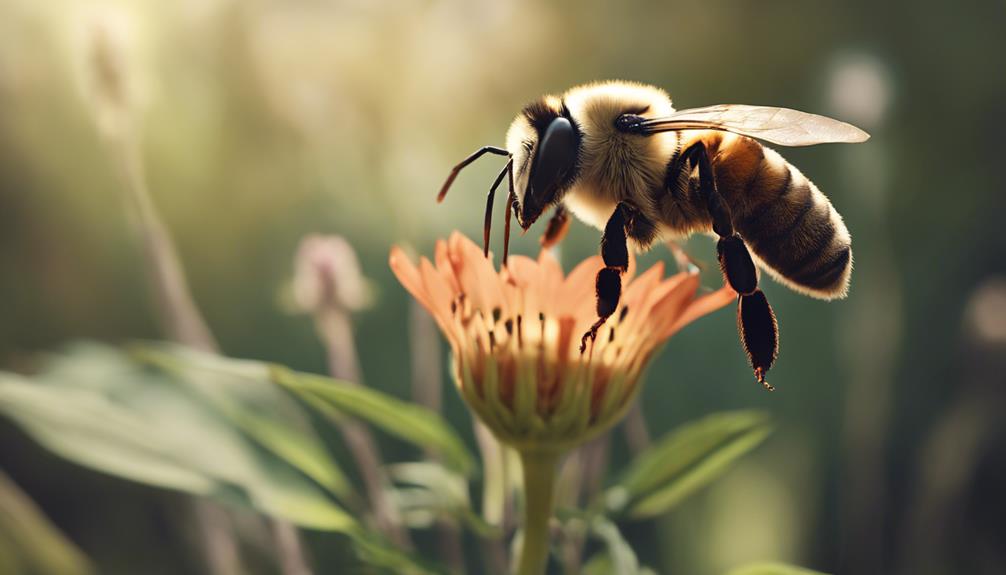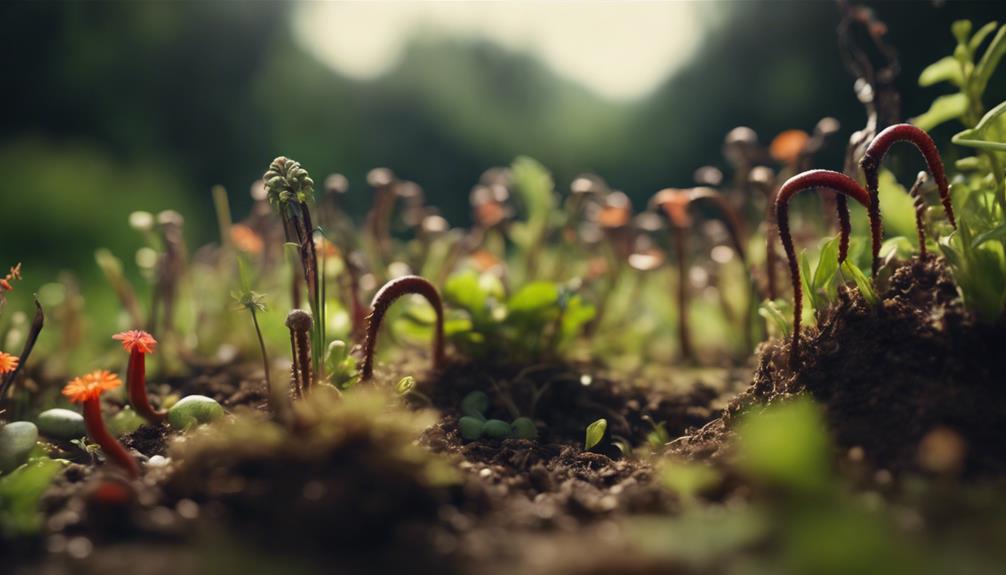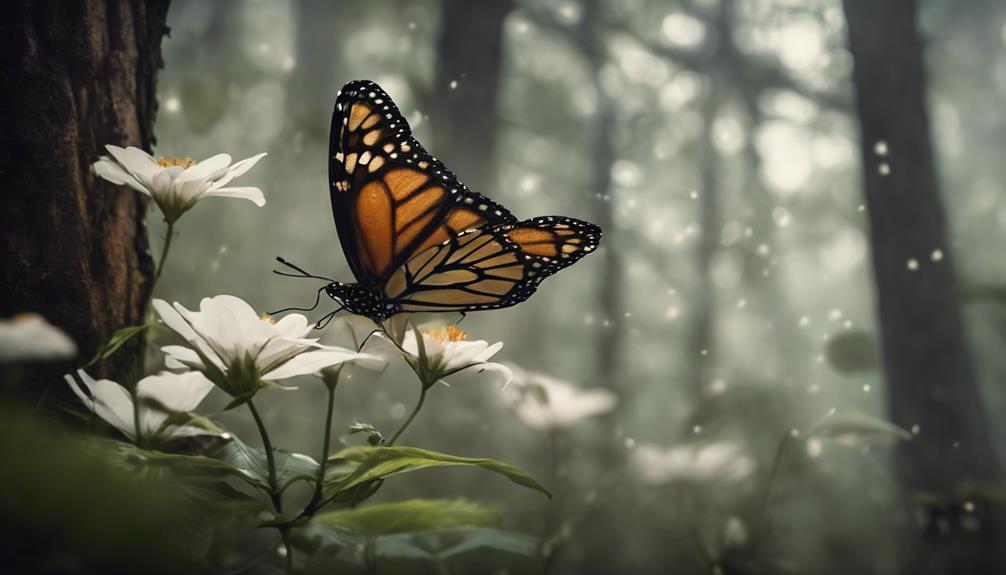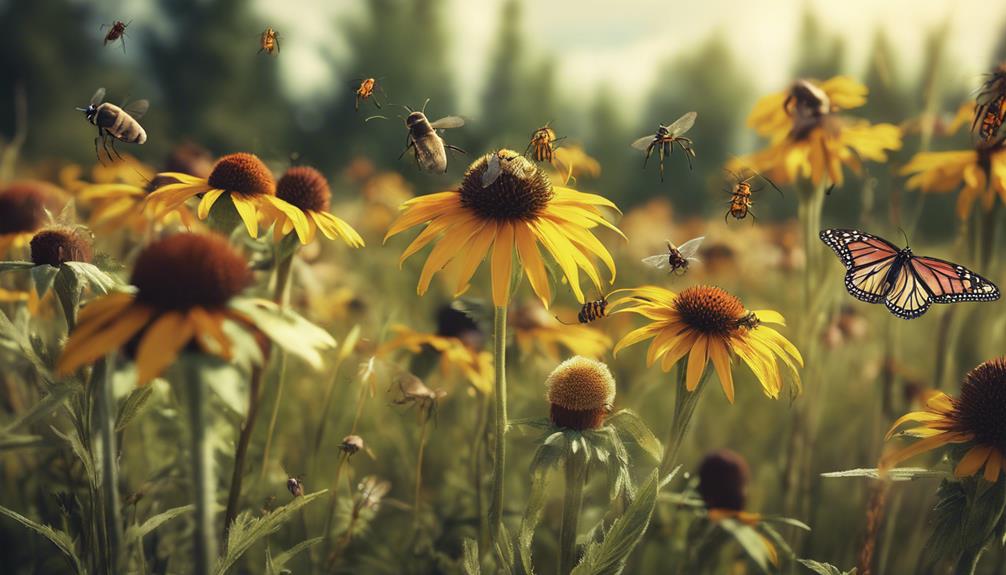By incorporating specific plants that have co-evolved with local wildlife, you're creating a delicate balance in your ecosystem. Native plants provide essential food sources, shelter, and habitat for a diverse range of species, while also supporting ecosystem services like pollination, pest control, and climate regulation. This balance is vital for maintaining soil health, reducing the need for chemical interventions, and preserving endangered species habitats. By choosing the right plants, you're not only supporting local wildlife but also contributing to a resilient ecosystem that can thrive in the face of climate change. And there's more to discover about the intricate relationships between plants and ecosystem balance.
Table of Contents
Key Takeaways
- Native plants support local wildlife by providing essential food sources, shelter, and habitat, maintaining ecosystem balance and promoting biodiversity.
- Specific plants attract specific pollinators, ensuring efficient pollination and fertilization, and supporting the local food chain.
- Incorporating native plants into a garden or landscape creates corridors for wildlife to move through, allowing them to find food, shelter, and mates.
- Native plants have evolved to thrive in local climate conditions, requiring less water, fertilizer, and pesticides, making them a sustainable choice for ecosystem balance.
- Choosing specific native plants supports ecosystem services, such as pollination, pest control, and climate regulation, essential for human well-being and environmental health.
Supporting Local Wildlife Habitats
By selecting plants native to your region, you can create a thriving habitat that sustains local wildlife, from pollinators and songbirds to larger mammals, and ultimately supports the delicate balance of the ecosystem.
By choosing plants that are native to your area, you're providing essential food sources for native wildlife. For instance, birds rely on native berries for sustenance, while pollinators need nectar from native flowers.
These plants have co-evolved with local wildlife over thousands of years, resulting in intricate relationships that are vital for their survival. A diverse range of native plants can support a wide variety of wildlife, from butterflies and bees to deer and rabbits, and even predators like owls and hawks.
By incorporating native plants into your garden or landscape, you're creating corridors for wildlife to move through, allowing them to find food, shelter, and mates, and thereby supporting ecosystem balance.
Enhancing Pollination and Fertilization
As you carefully select native plants for your garden, you're inadvertently orchestrating a intricate dance between flora and fauna, where each species plays a vital role in enhancing pollination and fertilization.
By choosing native plants, you're creating an ecosystem where specific pollinators are attracted to specific flowers. For instance, coneflowers and black-eyed susans rely on bees and butterflies for pollination, while cardinal flowers and trumpet vines rely on hummingbirds.
The shape, color, and scent of native flowers are tailored to attract specific pollinators, ensuring efficient pollination and fertilization. This precision is essential for the survival of pollinators and the ecosystem as a whole.
Providing Shelter and Food Sources

When selecting native plants for ecosystem balance, you'll want to think about how they can provide shelter and food sources for local wildlife.
By choosing plants that offer nutrient-rich food sources, you'll be supporting the growth and development of various animal species.
As you explore native plant selection, think about how you can create wildlife habitats that cater to the specific needs of local animals.
Native Plant Selection
You can substantially enhance ecosystem balance and biodiversity in your garden by selecting native plants that provide shelter and food sources for local wildlife, including birds, insects, and small mammals.
By choosing specific native plants, you'll create a haven for native pollinators like bees and butterflies, which rely on these plants for survival.
Native plants have evolved to thrive in local climate conditions, requiring less water, fertilizer, and pesticides, making them a sustainable choice for gardening.
Incorporating native plants into your garden will help maintain ecosystem services, such as pollination, pest control, and climate regulation, which are essential for human well-being.
By selecting native plant species, you'll support the local food chain, as native plants provide essential habitat and food sources for native wildlife, which in turn support apex predators and maintain ecosystem balance.
Wildlife Habitats Created
By incorporating native plants into your garden, you're creating a thriving haven that provides essential shelter and food sources for local wildlife, from birds and insects to small mammals and reptiles.
By planting native species, you're creating wildlife habitats that support the coexistence of different species within an ecosystem.
Native plants, such as coneflowers and black-eyed susans, offer nectar-rich flowers that attract pollinators like bees and butterflies, which are essential for plant reproduction and ecosystem health.
Native grasses and shrubs, like switchgrass and blueberry bushes, provide shelter and nesting sites for small mammals, birds, and reptiles, and serve as a food source for herbivores and omnivores.
By recreating natural ecosystems with native plants, you're supporting local wildlife and promoting ecosystem services.
This not only maintains biodiversity but also contributes to a balanced ecosystem.
Nutrient-Rich Food Sources
Native plants, rich in nutrients, offer a diverse array of food sources, including berries, seeds, and leaves, which are essential for the survival and thrival of local wildlife.
By choosing native plants like oak trees, you'll provide a fundamental food source for animals like deer, squirrels, and birds, supporting their growth and development.
Plants with complex structures, such as coneflowers and black-eyed susans, offer shelter and habitat for insects, reptiles, and small mammals, protecting them from harsh weather and predators.
You can also provide a key food source for pollinators like bees, butterflies, and hummingbirds by incorporating native plants that produce nectar-rich flowers, like butterfly milkweed and purple coneflower.
Additionally, by including native plants with diverse seed types, such as grasses and wildflowers, in your landscape, you'll support a wide range of bird species, from finches and sparrows to turkeys and quail, by providing them with a reliable food source.
Boosting Ecosystem Resilience Factors
Several ecosystem resilience factors can be boosted by strategically incorporating specific plant species into an ecosystem, as these plants have co-evolved to provide essential services that support ecosystem stability.
By choosing native plants, you can increase the chances of successful pollination and seed dispersal, as these plants have evolved to rely on each other for these processes.
This, in turn, can enhance ecosystem resilience to climate change and other disturbances.
- Diverse ecosystem services: Incorporating a diverse range of native plant species can provide a variety of ecosystem services, such as soil stabilization, water filtration, and habitat provision.
- Deep root systems: Native plants with deep root systems can improve ecosystem resilience by increasing soil carbon sequestration, reducing soil erosion, and providing a stable habitat for microorganisms.
- Constant food source: Using native plants with different phenologies, or growth patterns, can enhance ecosystem resilience by providing a constant source of food and habitat for wildlife throughout the year.
Maintaining Soil Quality and Health

As you focus on maintaining soil quality and health, you'll want to reflect on how specific plants can support soil nutrient cycling and microbial life balance.
By selecting plants that promote these processes, you can create an environment where nutrients are efficiently used and reused, and beneficial microorganisms thrive.
This, in turn, will help you build a resilient soil ecosystem that requires fewer external inputs and is better equipped to support a diverse range of plant and animal life.
Soil Nutrient Cycling
You can influence soil nutrient cycling by incorporating plants that fix atmospheric nitrogen, solubilize phosphorus, or mobilize micronutrients, thereby maintaining soil quality and health.
By choosing the right plants, you can create a balanced ecosystem where nutrients are cycled efficiently. This is especially important in ecosystems where soil degradation is a concern.
Native plants, for instance, have evolved to thrive in specific soil conditions and can help maintain soil health. They absorb carbon dioxide from the atmosphere, which is then stored in the soil, reducing the carbon footprint of the ecosystem. Additionally, these plants often have symbiotic relationships with microorganisms that facilitate nutrient cycling.
Three key benefits of incorporating plants that promote soil nutrient cycling are:
Improved soil fertility: Plants that fix nitrogen, solubilize phosphorus, or mobilize micronutrients increase the availability of essential nutrients for other plants to grow.
Enhanced ecosystem resilience: By maintaining soil health, you can reduce the risk of soil erosion, landslides, and other environmental disasters.
Increased biodiversity: A balanced ecosystem with healthy soil supports a diverse range of plant and animal species, promoting ecosystem balance and stability.
Microbial Life Balance
Maintaining microbial life balance is essential for soil quality and health, as microorganisms play a fundamental role in decomposing organic matter, fixing nitrogen, and solubilizing phosphorus.
Microorganisms are the unseen heroes of ecosystem services, and their delicate balance is vital for a thriving ecosystem.
When you choose native plants, you're providing a habitat for these microorganisms to flourish, which in turn supports the entire ecosystem. Native plants provide the necessary food and shelter for microorganisms, allowing them to perform their ecosystem services efficiently.
By supporting microbial life balance, you're ensuring that your soil remains healthy and fertile, capable of supporting a diverse range of plant and animal life.
This balance is delicate, and even slight disruptions can have far-reaching consequences. By choosing the right plants, you're taking a vital step towards maintaining the microbial life balance, which is essential for a healthy and resilient ecosystem.
Managing Pests and Diseases Naturally
By incorporating specific plant species into your ecosystem, you can create a balanced environment that naturally repels pests and diseases, reducing the need for chemical interventions. This approach not only promotes a healthier ecosystem but also helps native plants thrive. When you choose the right species, you're providing a natural defense system that helps them survive.
Three ways specific plants can help manage pests and diseases:
- Trap cropping: Certain plants, like marigolds, attract pests away from your desired crops, reducing damage and the need for pesticides.
- Companion planting: Planting species like basil alongside tomatoes can repel pests that target tomatoes, while also improving their flavor and growth.
- Biofumigation: Plants like mustard and radish release chemicals that can repel or kill pests and diseases, providing a natural form of pest control.
Preserving Endangered Species Habitats

Incorporating specific plant species into your ecosystem can also play a vital role in preserving endangered species habitats, as many of these species rely on particular plants for survival.
By creating native plant gardens and habitats, you can provide endangered species with the specific plants they need to thrive. For instance, the monarch butterfly relies on milkweed, while the Karner blue butterfly depends on native lupine.
Restoring natural habitats with native plants can markedly increase the population of endangered species, as seen in the 50% rise of the Karner blue butterfly after its habitat was restored. Urban areas can also be transformed into corridors for migration and dispersal by planting native species, supporting biodiversity.
However, removing invasive non-native species that outcompete native plants for resources, leading to a decline in endangered species populations, is imperative.
Mitigating Climate Change Effects Locally
You can play a crucial role in mitigating the effects of climate change locally by selecting and cultivating native plant species that are specifically adapted to thrive in your region. By doing so, you'll not only reduce your carbon footprint but also support local ecosystems that are more resilient to extreme weather events.
Three ways planting native species can make a difference:
- Carbon sequestration: Native plants can absorb up to 10 times more carbon dioxide from the atmosphere than non-native plants, helping to reduce the amount of greenhouse gases in the air.
- Water conservation: Native plants require less water and maintenance, reducing the need for fossil fuels and other resources that contribute to climate change.
- Urban heat island reduction: Planting native species in urban areas can help reduce the urban heat island effect, which can increase temperatures by up to 10°F (5.6°C) compared to surrounding rural areas.
Frequently Asked Questions
Why Are Plants so Important to an Ecosystem?
You recognize that plants are essential to an ecosystem as they drive food webs, facilitate soil formation, regulate climate, and produce oxygen, ultimately creating a thriving environment where you belong and can coexist with nature.
What Is the Role of Plants in Balancing the Environment?
You play a fundamental role in balancing the environment by recognizing plants' essential functions: purifying the air, preventing soil erosion, regulating the climate, and filtering water, ultimately sustaining life and promoting a thriving ecosystem.
What Role Do Plants Play in Economic Balance?
As you wander through a lush forest, you're surrounded by nature's financial wizards: plants! They play a vital role in economic balance by driving carbon sequestration, offering economic incentives, optimizing resource allocation, and influencing market dynamics.
Why Are Native Plants so Important to the Ecosystem?
You recognize the crucial role native plants play in maintaining ecosystem balance, as they preserve cultural significance, enhance soil quality, provide essential wildlife habitat, and foster climate resilience, ultimately sustaining the delicate harmony of your ecosystem.
Conclusion
As you tend to your ecosystem, imagine you're a master conductor, orchestrating a symphony of life.
Each plant is a unique instrument, playing its part in harmony with others.
By choosing the right plants, you're fine-tuning the melody of your ecosystem, creating a resilient and thriving community.
Every note, every beat, every species works together in perfect harmony, creating a masterpiece of balance and beauty.

